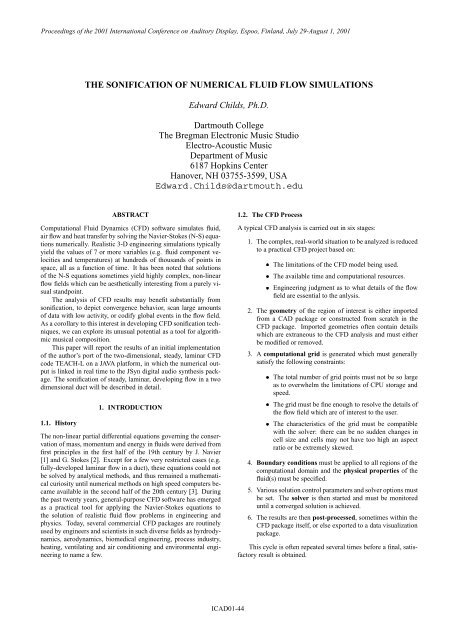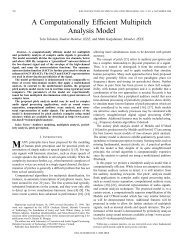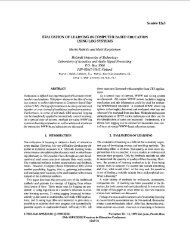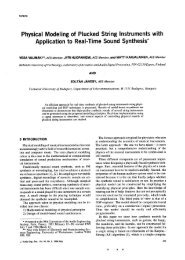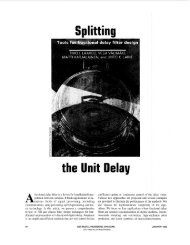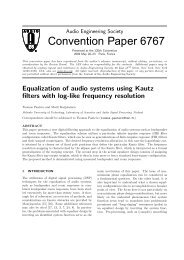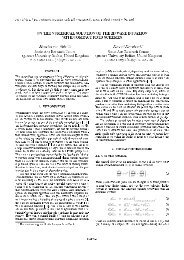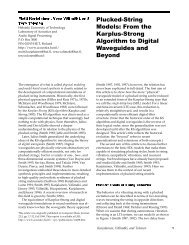The sonification of numerical fluid flow simulations
The sonification of numerical fluid flow simulations
The sonification of numerical fluid flow simulations
You also want an ePaper? Increase the reach of your titles
YUMPU automatically turns print PDFs into web optimized ePapers that Google loves.
Proceedings <strong>of</strong> the 2001 International Conference on Auditory Display, Espoo, Finland, July 29-August 1, 20012. PHYSICAL AND MATHEMATICAL BASIS OF THECFD SOLVER2.1. <strong>The</strong> Governing EquationsIn the case <strong>of</strong> steady, two-dimensional <strong>flow</strong>, the continuity (conservation<strong>of</strong> mass) equation is:Ü´Ùµ · ´Úµ ¼ (1)Ýwhere is the local <strong>fluid</strong> density (kg/m ¿ ), Ù and Ú are the local<strong>fluid</strong> velocities (m/s) and Ü and Ý (m), correspond to the cartesiancoordinate system.For incompressible <strong>flow</strong>, the momentum equations are for theÜ direction:Ù Ù Ù ·ÚÜ Ý ÔÜ · Ü´¾ ÙÜ µ· Ù ´Ý Ý · Ú ℄µ (2)Üand for the Ý direction:Figure 2: Vectorsit uses are iterative by nature, and generate numbers that evolveover time. <strong>The</strong>re is therefore a potential for CFD to generate livemusical compositions.1.5. Scope <strong>of</strong> Present WorkThis paper will focus on the real-time <strong>sonification</strong> <strong>of</strong> Stage 5 (solution)<strong>of</strong> the CFD process.An academic CFD research code TEACH-L [8], originallywritten in FORTRAN, was ported by the author to Java in orderto make use <strong>of</strong> JSyn [9], a digital audio synthesis package.JSyn (Java Synthesis) is a Java API (application programminginterface), which provides several classes <strong>of</strong> objects that can createand modify sound. A fast DSP synthesis package written inC lies beneath JSyn’s hood. All Java synthesis calls are passedtransparently to the C engine.TEACH-L solves the steady, laminar equations <strong>of</strong> the conservation<strong>of</strong> mass, momentum (Navier-Stokes) and energy on a twodimensional,cartesian grid, using a hybrid differencing sheme andthe SIMPLE (Semi-Implicit Method for Pressure-Linked Equations)algorithm [10] to correct the pressure field. <strong>The</strong> algebraicequations are solved line-by-line (LBL), using the tri-diagonal matrixalgorithm (TDMA). <strong>The</strong> TEACH-L code is extremely compact.<strong>The</strong>re is no user-interface. To set up the geometry, grid,boundary conditions, and physical properties, the user must writeher own subroutines using the templates provided. This structurewas retained in the Java port, so that TEACH-L consists <strong>of</strong> a CFDAPI.<strong>The</strong> compactness <strong>of</strong> TEACH-L, together with the flexibility <strong>of</strong>the JSyn API, afforded a reasonable implementation on a MacintoshG3 Powerbook, providing a tool for the in-depth exploration<strong>of</strong> various <strong>sonification</strong> strategies for a CFD solver.In the following sections, the physical and mathematical basis<strong>of</strong> TEACH-L will be presented. One <strong>sonification</strong> strategy will beexplored, followed by results and conclusions.Ù Ú Ú · ÚÜ Ý ÔÝ ·Ü´ ÚÜ · ÙÝ ℄µ · Ý´¾ÚÝ µ(3)where is the acceleration due to gravity (m/s ¾ ), Ô is the <strong>fluid</strong>static pressure (Pa) and is the <strong>fluid</strong> dynamic viscosity (kg/ms).<strong>The</strong> energy conservation equation for the <strong>fluid</strong>, neglecting viscousdissipation and compression heating, is: Ô´Ù ØÜ · Ú ØÝ µÜ´ ØÜ µ·ÝØ ´ µ (4)Ýwhere Ô is the <strong>fluid</strong> specific heat at constant pressure (J/kg K), is the <strong>fluid</strong> thermal conductivity (W/m K), and Ø is the <strong>fluid</strong> staticpressure (K).2.2. DiscretizationTo solve the non-linear partial differential equations from the previoussection, it is necessary to impose a grid on the <strong>flow</strong> domain<strong>of</strong> interest, see Fig. 3. In TEACH-L, discrete values <strong>of</strong> <strong>fluid</strong> velocities,properties, pressure and temperature, are stored at each gridpoint (the intersection <strong>of</strong> two grid lines). To obtain a matrix <strong>of</strong> algebraicequations, a control volume is constructed (shaded area inthe figure) whose boundaries (shown by dashed lines) lie midwaybetween grid points È and its neighbors Æ, Ë, , Ï . A complexprocess <strong>of</strong> formal integration <strong>of</strong> the differential equations over thecontrol volume, followed by interpolation schemes to determine<strong>flow</strong> quantities at the control volume boundaries (Ò, ×, , Û) inFig. 3, finally yield a set <strong>of</strong> algebraic equations for each grid pointÈ [11]:´ È µ È (5)where the subscript on È , and refers to a summation overneighbor nodes Æ, Ë, and Ï , is a general symbol for thequantity being solved for (Ù, Ú or Ø), È , etc. are the combinedconvection-diffusion coefficients (obtained from integration andinterpolation), and and are, respectively, the implicit andexplicit source terms (and generally represent the force(s) whichdrive the <strong>flow</strong>, e.g. a pressure difference).ICAD01-46
Proceedings <strong>of</strong> the 2001 International Conference on Auditory Display, Espoo, Finland, July 29-August 1, 2001only one line at a time is solved, quantities on other lines are consideredto be “known”. Thus, a smaller Ò ¢ Ò tri-diagonal matrixresults, where Ò is the number <strong>of</strong> nodes in the direction. <strong>The</strong>solver starts at the first -index line in the solution domain, and“sweeps” from left to right.Because the partial differential equations are non-linear, theresulting algebraic matrix equations will be also, that is, the convection-diffusioncoefficients È , etc. will themselves be functions<strong>of</strong> the ’s. An iterative solution is thus required, as follows:1. <strong>The</strong> coefficients for Eq.(5) in which Ù are formed, andthe current global “error” or “residual” is calculated. <strong>The</strong>matrix <strong>of</strong> coefficients is solved by LBL and new values <strong>of</strong> Ù are obtained.2. <strong>The</strong> same is done for Ú and Ø.3. A “pressure correction” equation, derived from the massconservation equation is solved in a similar manner, the values<strong>of</strong> pressure at each note are updated [10].4. <strong>The</strong> global errors calculated in each <strong>of</strong> the above steps arethen all compared to a set <strong>of</strong> target values. If these errorsfall below the target, the solution has converged and the calculationstops. Otherwise, the calculation resumes at step 1.2.4. Solution Control Parameters2.3. SolutionFigure 3: Control VolumeEquation (5) must be written at each node where the value <strong>of</strong> È isrequired; doing so will generate an Æ ¢ Æ matrix <strong>of</strong> simultaneousequations, where Æ is the number <strong>of</strong> nodes in the solution domain.It is usually impractical to invert this matrix directly, so instead aline-by-line (LBL) scheme is used, see Fig. 4. In the LBL scheme,<strong>The</strong>re are two sets <strong>of</strong> parameters which are set by the user to controlthe progress <strong>of</strong> the solution, the underrelaxation factors andthe sweep controls. In an iterative, <strong>numerical</strong> solution, underrelaxationslows the rate <strong>of</strong> change <strong>of</strong> a variable from one iterationto the next. Underrelaxation is necessary for <strong>numerical</strong> stabilityand to avoid divergence <strong>of</strong> the solution. Sweep controls for eachvariable are set to control the number <strong>of</strong> times, per iteration, theLBL procedure is applied to the coefficient matrix. <strong>The</strong> greater thenumber <strong>of</strong> sweeps, the better the matrix inversion at a particulariteration (but the greater the amount <strong>of</strong> CPU time required.)3. DUCT FLOW EXAMPLEAs an example <strong>of</strong> a solver <strong>sonification</strong>, the simple problem <strong>of</strong>steady, laminar, two-dimensional developing <strong>flow</strong> in a planar ductwill be considered (see Fig. 5). In this <strong>flow</strong> situation, <strong>fluid</strong> entersat the left with a uniform velocity pr<strong>of</strong>ile, which develops, asthe <strong>fluid</strong> reaches the end <strong>of</strong> the duct on the right, into a parabolicpr<strong>of</strong>ile which is characteristic <strong>of</strong> “fully-developed” <strong>flow</strong>, Eq. 6:µ = 1.0 kg/msρ = 1.0 kg/m^3Uin = 1.0 m/s0.5 mFigure 4: Line-By-Line Scheme1.0 mFigure 5: Developing Flow in a 2D DuctÙ ¿ ¾Ý¾ÙÑ´½ µ (6)¾ where ÙÑ is the average velocity (in this case, 1 m/s), is theheight (in this case 0.5 m) and Ý ¼at the centerline <strong>of</strong> the duct.ICAD01-47
Proceedings <strong>of</strong> the 2001 International Conference on Auditory Display, Espoo, Finland, July 29-August 1, 2001When the <strong>flow</strong> is fully developed, the transverse velocity componentÚ vanishes, and the pressure Ô changes only linearly with Ü:¡Ô ½¾ÙÑ¡Ü ¾ (7)which gives the pressure drop ¡Ô over some Ü-direction length¡Ü, and where the viscosity is in this case 1 kg/ms.A coarse ¢ evenly spaced grid was used, yielding a total <strong>of</strong> ¢ ¾internal or “live” cells at which the values <strong>of</strong> Ù, Ú andÔ are updated at each iteration by the solver. With this very simpleconfiguration, the solver converges in about 20 iterations.3.1. Sonification Strategy<strong>The</strong> purpose <strong>of</strong> this <strong>sonification</strong> was to gain insight into the solverby listening to its progress in real time. To accomplish this, 5 sineoscillators were set up to correspond to each column <strong>of</strong> “live” gridpoints. As the solver (for Ù, Ú then Ô) sweeps through the domainfrom left to right, first the column at ½sounds, from ½ ,with slight arpeggiation, and so on, with a slight pause for eachcolumn, through . Thus, each iteration produces 25 notes pervariable, for 75 total.In most CFD <strong>simulations</strong>, general trends and <strong>flow</strong> behaviorare known to the engineer in advance <strong>of</strong> the calculation. In this<strong>sonification</strong>, the pitch strategy for each variable was selected sothat the anticipated behavior in the <strong>flow</strong> direction could be “heard”:1. Development <strong>of</strong> Ù from a flat to a parabolic pr<strong>of</strong>ile.2. Vanishing <strong>of</strong> Ú.3. Linear decrease <strong>of</strong> Ô in the <strong>flow</strong> direction.3.1.1. Pitch Mapping<strong>The</strong> values <strong>of</strong> Ù range from uniformly 1.0 at the inlet (near ½) to values in the range ¼¼ Ù ½ at the <strong>flow</strong> exit (near ). <strong>The</strong> initial guess for Ù throughout the domain is 0.0. Asthe solution iterates, values <strong>of</strong> Ù well in excess <strong>of</strong> 1.5 may result.<strong>The</strong> values <strong>of</strong> Ù were mapped to pitch and scaled so that a value <strong>of</strong>Ù ½would yield 440 Hz, with 55 Hz set as the minimum valuefor values <strong>of</strong> Ù¼½¾.<strong>The</strong> values <strong>of</strong> Ú range from approximately 0.1 near the inletto very small numbers near the exit (the initial guess throughoutthe <strong>flow</strong> field, as for Ù, isÚ ¼¼). <strong>The</strong> values <strong>of</strong> Ú were alsomapped to pitch, but scaled up so that a value <strong>of</strong> Ú ½ wouldyield 8400 Hz. All nodes with values <strong>of</strong> Ú about ¼¼ weremapped to a major triad with pitches (150, 300, 375, 450) Hz, fornodes ¾.<strong>The</strong> values <strong>of</strong> Ô in incompressible <strong>fluid</strong> <strong>flow</strong> are generally calculatedrelative to some <strong>numerical</strong>ly convenient reference value,in this case Ô Ö ½¼ Pa at node ´ µ ´½ ½µ. Values <strong>of</strong> Ô arecalculated relative to Ô´½ ½µ, where the significant pressure informationis the ¡Ô between nodes which drives the <strong>flow</strong>. Using thisscheme, the values <strong>of</strong> Ô range from ¼ Ô ½¼. <strong>The</strong> localvalue <strong>of</strong> Ô was added to a different major triad (100, 200, 300, 400,500) Hz for ½. Because the values <strong>of</strong> the pressure arefairly uniform at each location, one hears, for this scheme, a succession<strong>of</strong> major triads whose pitch either increases, decreases orstays the same.3.1.2. Envelope<strong>The</strong> envelope (attack, sustain, decay) characteristics were derivedfrom the matrix coefficients for each variable at each node:Ø ½ Æ ½ Æ È Ø ¾ Ë ¾ Ë È Ø ¿ (8) ¿ È Ø Ï Ï È Ø ½¼ ¼¼Equations 8 represent a 5 frame envelope where ½ is the amplitude<strong>of</strong> the first frame, Ø ½ is its rise time, etc. <strong>The</strong> values for thefifth frame are set to constant values <strong>of</strong> 1.0 and 0.0 respectively toensure that the oscillator will turn <strong>of</strong>f. <strong>The</strong> values <strong>of</strong> Ø ½ were constrainedto be at least 0.05 secs, to avoid clicks due to zero-lengthframes. Division <strong>of</strong> all neighbor coefficients Æ, etc. by the centercoefficient È ensures that ¼¼ Ò ½¼, since the centercoefficient is always greater in magnitude than its correspondingneighbors.3.1.3. DurationIn general, as the solver proceeds and makes available the latestvalues <strong>of</strong> variable and coefficient at each node, the mapped pitchesand envelopes were queued to the oscillators. However, to makethe sonic result more intelligible, some delays were added. Firstly,very slight delays were added between nodes in each column, toproduce something like an arpeggiated chord. Secondly, a longerdelay was added at the conclusion <strong>of</strong> each column, before proceedingto the next column. Thirdly, at the conclusion <strong>of</strong> the <strong>sonification</strong><strong>of</strong> a variable at all 25 nodes, a longer delay was added proportionalto the global error calculated for that variable. Thus, as thecalculation proceeds, this delay decreases as the error is reduced.Finally, at the conclusion <strong>of</strong> a single iteration, a longer delay wasadded. It is thus possible for the listener to distinguish, based onthe delay between notes, the different stages <strong>of</strong> the calculation.3.1.4. TimbreNo specific timbral mapping was attempted, since a sine oscillatorwas used for all notes. However, because each note was given aunique envelope, some striking timbral differences resulted, mainlyfrom different attack times.4. RESULTS<strong>The</strong> parameter/variable mapping choices described in the previoussection had the following effects:¯ <strong>The</strong> Ù velocity <strong>sonification</strong> captured the oscillations <strong>of</strong> thesolver well. <strong>The</strong> solver initial guess <strong>of</strong> Ù ¼was followed,at the second iteration, by values considerably overshootingthe final result. This behavior sounded like a sequenceICAD01-48
Proceedings <strong>of</strong> the 2001 International Conference on Auditory Display, Espoo, Finland, July 29-August 1, 2001<strong>of</strong> low, followed by high frequency chord progressions, finallysettling out to a noticeably repeating sequence duringthe final iteration. Owing to large values <strong>of</strong> the neighborcoefficients Æ, etc. and the large values <strong>of</strong> center coefficient È at most nodes relative to the neighbors, the attacktimes were long, and the amplitudes low. Thus the Ù velocity<strong>sonification</strong> sounded ethereal and slowly evolving andwas easily distinguished from the Ú velocity and Ô data.¯ From the Ú velocity <strong>sonification</strong>, it was easy to hear an initialguess <strong>of</strong> Ú ¼, via the major chord, followed, afteroscillations, by non-zero (higher frequency) sounds at theinlet, and vanishing values near the <strong>flow</strong> exit. <strong>The</strong> attacktimes for this variable were shorter than those for the Ù velocity,and the amplitudes higher. It was thus easy to hearthe transition from the Ù to Ú <strong>sonification</strong>.¯ <strong>The</strong> Ô <strong>sonification</strong> was very different in timbre to those forÙ and Ú, owing to much shorter attack times and higher amplitudes.It was thus easy to perceive the onset <strong>of</strong> Ô data,and to hear, at each iteration, whether the pressure was increasing,staying the same, or finally, as in the convergedsolution, decreasing in the direction <strong>of</strong> <strong>flow</strong>.5. CONCLUSIONS<strong>The</strong> <strong>sonification</strong> <strong>of</strong> this simple duct example afforded enhancedinteraction with the data in two important ways:1. <strong>The</strong> ability to monitor the progress <strong>of</strong> convergence <strong>of</strong> thedata throughout the <strong>flow</strong> field. In most CFD packages, visualmonitoring <strong>of</strong> solution progress is only practical at oneor two locations. <strong>The</strong> addition <strong>of</strong> sound allows the engineerto hear that, on a global basis, the solution is or isn’tevolving as expected, and roughly where in the domain aproblem might exist if there is one.2. <strong>The</strong> ability to notice differences in data (the neighbor andcenter coefficients), via the envelope characteristics. <strong>The</strong>different timbres in the three variables aroused curiosity,and triggered further investigation <strong>of</strong> these coefficients, inorder to determine if their values were correct, and to questionwhy they were different for each variable.7. MUSICAL COMPOSITIONS<strong>The</strong> duct <strong>flow</strong> example was used as an algorithmic compositiontool by recording several solver runs with different parameter settingsso as to change the tempi or pitch centers. Various soundfileswere created, processed, and mixed using ProTools s<strong>of</strong>tware.8. REFERENCES[1] C.L.M.H. Navier, Memoires Acad. R. Sci., Paris, Vol. 6, pp.389-416, 1830.[2] G.G. Stokes, Trans. Camb. Phil. Soc., Cambridge, Vol. 8, pp.287-308, 1845.[3] J.E. Fromm and F.H. Harlow, “Numerical solutions <strong>of</strong> theproblem <strong>of</strong> vortex street development,” Phys. <strong>of</strong> Fluids, 6,975-982, 1963.[4] K. McCabe and A. Rangwalla, “Auditory Display <strong>of</strong> ComputationalFluid Dynamics Data,” in Auditory Display, Ed.G. Kramer, SFI Studies in the Sciences <strong>of</strong> Complexity, Proc.Vol. XVIII, Addison-Wesley, Reading, MA, USA, 1994.[5] H. Schlichting, Boundary Layer <strong>The</strong>ory, McGraw Hill, NewYork, 1979.[6] I. Xenakis, Formalized Music, Indiana University Press,Bloomington, 1971.[7] I. Xenakis, Arts/Sciences: Alloys, Pendragon Press, NewYork, 1985.[8] A.D. Gosman, B.E. Launder, F.C. Lockwood andG.C. Reece, Imperial College <strong>of</strong> Science and Technology,Mechanical Engineering Department, London SW72BX, series prepared under the auspices <strong>of</strong> the NationalDevelopment Progam in Computer Assisted Learning, 1975.[9] JSyn is a new technology developed by Phil Burk at S<strong>of</strong>t-Synth (http://www.s<strong>of</strong>tsynth.com).[10] D.B. Spaulding, Int. J. Num. Meth. Engng., Vol. 4, pp. 551-559, 1972.[11] S.V. Patankar, Numerical Heat Transfer and Fluid Flow, Mc-Graw Hill, New York, 1980.In general, it is clear that the addition <strong>of</strong> sound has enormouspotential for the critical examination <strong>of</strong> CFD <strong>simulations</strong> and meritsfurther investigation.6. FURTHER WORK<strong>The</strong> current <strong>sonification</strong> was extended to add spatialization <strong>of</strong> thesound, so as to hear a sweeping progression from left to right.More complex “instruments” were constructed, to enhance the effect<strong>of</strong> local coefficients, and to add the effect <strong>of</strong> additional coefficientsnot currently mapped, such as source terms, and localconservation errors.<strong>The</strong> ultimate goal should be to map every available parameterin the <strong>numerical</strong> world to some recognizable characteristic inthe sound domain, in such a way that it can be distinguished andsingled out for inspection and further investigation if warranted.ICAD01-49


